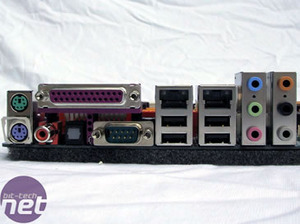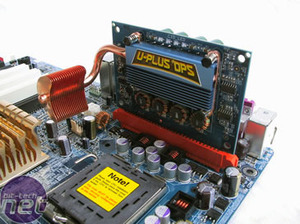Gigabyte has also included two of their usual technologies: Dual BIOS technology which prevents bad BIOS flashing by having a backup onboard and Universal-Plus Dual Power System (U-Plus DPS), which is an optional plug in component that goes in the top left orange slot. Basically it adds another 4-phase power regulation to the motherboards 4 phase giving you two fold better power regulation for the CPU.
It is important because the latest CPUs easily kick out in excess of 100W of heat, so dissipating this power requirement across 8 rather than the standard 4 power reg’s provides a cooler motherboard, and a more stable motherboard as well as giving the end user more headroom in overclocking.
The board uses the latest ALC882M codec for their Intel Azalia HD audio, which not only supports the now standard 7.1 channel sound but also Dolby Master Studio. Dolby Labs require stringent conditions to conform to their specification and the Dolby Master Studio is their top spec for onboard audio supporting:

 There are a lot of little things that make the board just that much better thought out - you can tell the engineers have either suffered from the same problems you or I have, or have listened to community and customer feedback and have finally cured those little niggles (like changing the PCI-Express x16 socket clip to be on the top, not bottom so it’s easier to remove a graphics card) - a big well done to Gigabyte.
There are a lot of little things that make the board just that much better thought out - you can tell the engineers have either suffered from the same problems you or I have, or have listened to community and customer feedback and have finally cured those little niggles (like changing the PCI-Express x16 socket clip to be on the top, not bottom so it’s easier to remove a graphics card) - a big well done to Gigabyte.
Annoyingly, you are required to do the Ctrl+F1 trick in order to open up the enthusiast options for memory timings and CPU multiplier adjustment (if supported by your CPU) in the M.I.T section. As far as we are aware it’s the only company that does this and we can’t understand why to be honest. There’s no reason to hide it and there are other, more damaging options like voltage adjustments unhidden. Also it’s not mentioned anywhere on their website or in the manual so a lot of uninformed end users will just assume these options are not supported.
Finally, we have Gigabyte's alternative to Asus NOS: the CIA2. The CPU Intelligent Accelerator has different levels within it (Cruise, Sports, Racing, Turbo and Full Thrust) that allows you to set levels of overclocking between 5-7% at Cruise and 17-19% at Full Thrust.
The CIA will automatically overclock your CPU when it sees a loaded processor to maximise performance, then clock it down when it’s at idle to minimise heat output. While this may appeal to some, we still like to do things the old school way of ramping up the front side bus, and anything less than 10% will generally be unnoticeable.
It is important because the latest CPUs easily kick out in excess of 100W of heat, so dissipating this power requirement across 8 rather than the standard 4 power reg’s provides a cooler motherboard, and a more stable motherboard as well as giving the end user more headroom in overclocking.
The board uses the latest ALC882M codec for their Intel Azalia HD audio, which not only supports the now standard 7.1 channel sound but also Dolby Master Studio. Dolby Labs require stringent conditions to conform to their specification and the Dolby Master Studio is their top spec for onboard audio supporting:
- 8-channel audio
- 24-bit/96KHz High Definition sound support
- Dolby Digital Live
- Dolby Headphone
- Dolby Virtual Speaker
- Dolby Pro Logic IIx - from DVD playback and full authoring to games and music.


BIOS
Gigabyte use a standard Award BIOS which give the usual range of options for controlling the boards features. Gigabyte's unique feature is their M.I.T: Motherboard Intelligent Tweaker, which is Gigabyte's centre for overclocking and performance tweaking options. As well as the usual clock and voltage options for CPU, Memory, PCI-Express and FSB, you have a memory multiplier to be able to run asynchronous memory speeds faster than the CPU bus, like DDR2 667, 800 and 888 providing your DDR2 memory is up to it. Also, you have the “Robust Graphics Booster” which gives you the accurate options of “fast” and “turbo”; basically it just overclocks the PCI-Express x16 slot.Annoyingly, you are required to do the Ctrl+F1 trick in order to open up the enthusiast options for memory timings and CPU multiplier adjustment (if supported by your CPU) in the M.I.T section. As far as we are aware it’s the only company that does this and we can’t understand why to be honest. There’s no reason to hide it and there are other, more damaging options like voltage adjustments unhidden. Also it’s not mentioned anywhere on their website or in the manual so a lot of uninformed end users will just assume these options are not supported.
Finally, we have Gigabyte's alternative to Asus NOS: the CIA2. The CPU Intelligent Accelerator has different levels within it (Cruise, Sports, Racing, Turbo and Full Thrust) that allows you to set levels of overclocking between 5-7% at Cruise and 17-19% at Full Thrust.
The CIA will automatically overclock your CPU when it sees a loaded processor to maximise performance, then clock it down when it’s at idle to minimise heat output. While this may appeal to some, we still like to do things the old school way of ramping up the front side bus, and anything less than 10% will generally be unnoticeable.

MSI MPG Velox 100R Chassis Review
October 14 2021 | 15:04






Want to comment? Please log in.